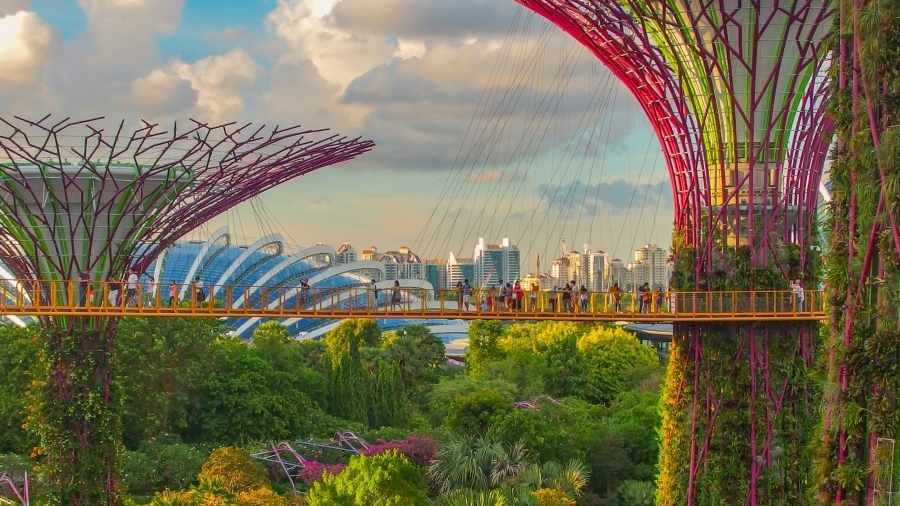 Photo by Coleen Rivas on Unsplash
Photo by Coleen Rivas on Unsplash
4 cool building strategies that mitigate the rising heat in Singapore
Singapore’s warming rate is double the global average at 0.25 degrees Celsius per decade.
By 2050, it is anticipated that Singapore will experience daily mean air temperatures exceeding 28.4°C, marking a new record for the city-state’s annual temperature highs.
Cooling becomes a challenge because Singapore is warming up at a rate twice as fast as the global average at 0.25°C per decade, according to the Meteorological Services. This climatic shift is prompting real estate developers to reconsider their design strategies for heat mitigation, going beyond traditional methods such as air-conditioning and greenery.
One way developers are reducing Singapore’s urban heat is through proper orientation of buildings.
A prime example of a well-positioned building in Singapore is the Khoo Teck Puat Hospital (KTPH), according to RSM Singapore partner, Dennis Lee.
“The hospital was actually built next to a lake, so they did a study of the wind patter and realised that the wind actually moves in a certain direction if you put the building at a certain orientation. As a result, the way the wind moves during certain parts of the day actually reduces the need for them to use fans or even use air conditioning,” Lee told the Singapore Business Review.
Lee added that since the hospital was in a reservoir area, the developers included it as one of the elements that played into the design of the building.
To illustrate, he pointed out three areas that provide shade. “You should take advantage of that share on the positioning aspect and consider it as part of your design,” he said. “Not only does it block out the sun, it also reduces glare and reduces build up into lower temperatures of the buildings.”
In the same token, developers must also position their buildings in a way that natural light can enter the building to reduce electricity use for lighting, Lee added.
Build at the top
Unlike new properties, it will be harder for developers to incorporate heat mitigation strategies for existing buildings.
In the case of Singapore’s famous Orchard Road, it will be difficult to install chilling technologies and redevelop from the ground up, given that there are a lot of train tracks. For this reason, Lee suggested making changes from the top of the building.
“What some developers do is build up — for example, having car parks at the top of the building rather than the bottom,” he said.
“Car parks at the top actually shelter and reduce heat intensity flow right down to the fifth, fourth, third, second, and first floor. It reduces temperature transfer,” the expert added.
The top is also ideal for the incorporation of greenery which, Lee said, will not only make the building more visually appealing but also block out heat and glare. “The gaseous exchange of plants actually helps to cool the area down,” he said.
One of the buildings in Singapore which had incorporated a roof garden and façade greenery is CapitaGreen.
Tony Chan, Arup’s Planning leader for South-east Asia, said the façade greenery on the CapitaGreen building alongside the roof garden have helped minimise heat build-up in the building. This was also similarly done for the CapitaSpring building.
Data from Arup showed that areas in Singapore which have lowest temperatures tend to have a very high percentage of greenery of about 70%-80%.
“A driver of this is also Singapore authorities’ commitments to green targets, including a higher emphasis on green buildings and encouraging more greenery and spaces, including on roofs of buildings as well as on building facades.” Chan said.
Chan cited PARKROYAL COLLECTION Pickering and CapitaSpring as other examples of buildings that exemplify the use of greenery.
Thermodynamic paints, photocatalytic pavements
In terms of building materials, Chan suggested the use of thermodynamic paints which respond dynamically to environmental conditions, adjusting reflectance and emissivity based on ambient temperature and light intensity, as well as high albedo/ reflective paint to reduce heat gain in buildings.
Apart from using paint technology that can dissipate heat faster, Lee said it is also important to choose the right colour of paint.
“If you paint your building black, obviously, the tropical setting would be difficult, but if you choose more natural tones and shades, it helps reduce heat concentration,” Lee said.
Lee said there’s also a study on the use of nanocrystals in paints.
Citing Arup’s project with the Greater London Authority, Chan said they are also assessing how much temperature can be reduced by covering roofs of buildings with solar panels and high-albedo light coloured paints.
In Singapore, Chan said the Urban Redevelopment Authority (URA)’s ‘Shaping a Heat Resilient City' exhibition also showcased building surface materials that mimics the skin texture of elephants for passive cooling. This biomimicry concept uses nature- inspired design for more sustainable and environmentally friendly buildings.
“That sort of irregular shape actually cools and moves heat away quickly from the surface,” Chan explained.
North-South Corridor
Chan believes the best strategy that can really help mitigate heat in Singapore is the government’s North-South Corridor (NSC) project.
The NSC is a “multi-modal transportation corridor” aimed at enhancing connectivity from the northern region to the city. Whilst NSC is generally a transportation project, Chan believes it also addresses Singapore’s temperature problem.
Chan explained that the project aims to push the road underground and have the upper level be green for pedestrians, for walking, and for green activities.
“Other government projects helping to cool Singapore include district cooling systems that reduce the need for individual air-conditioning units which emit anthropogenic heat directly into their immediate surroundings,” he said.
























 Advertise
Advertise










